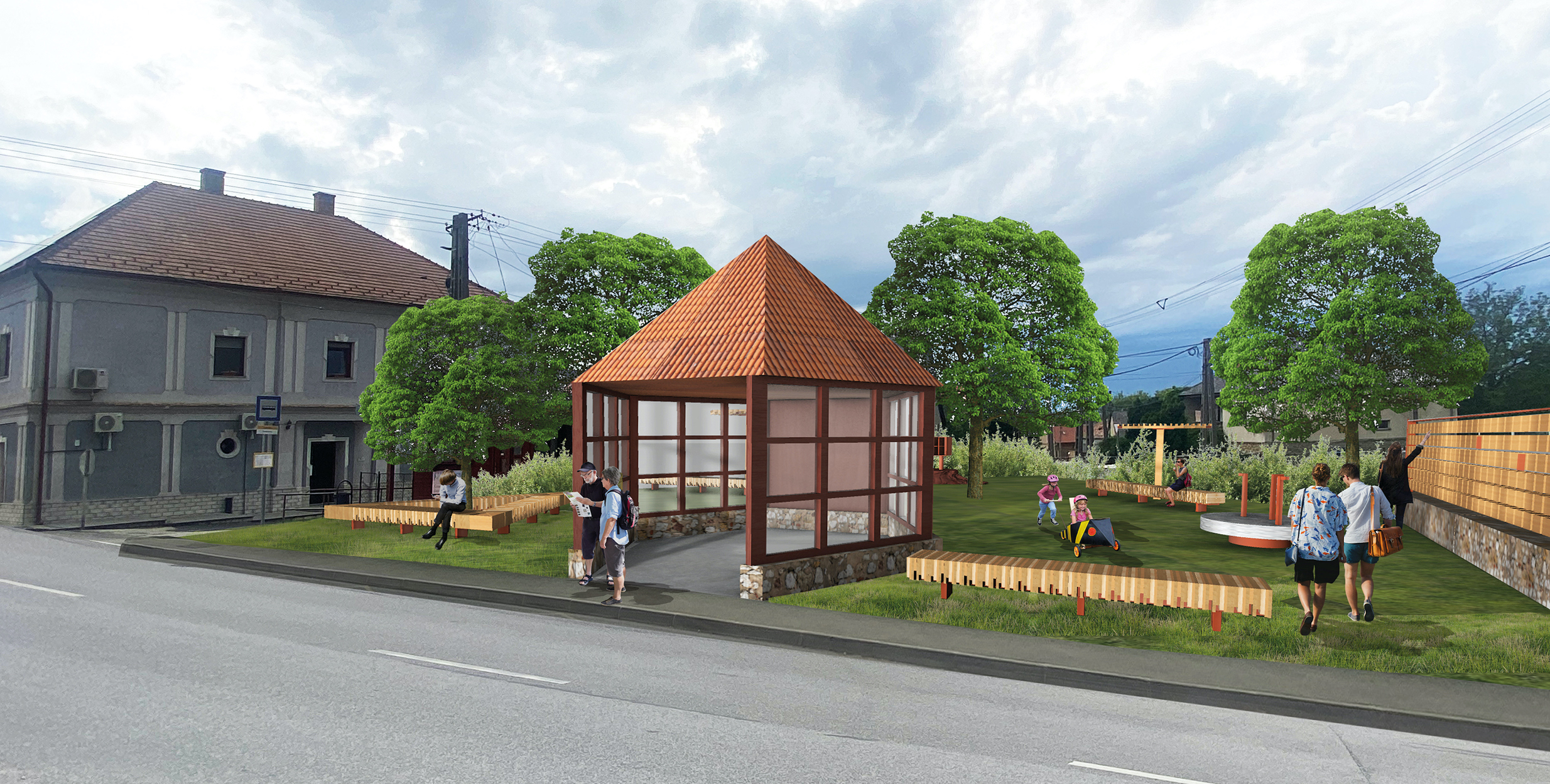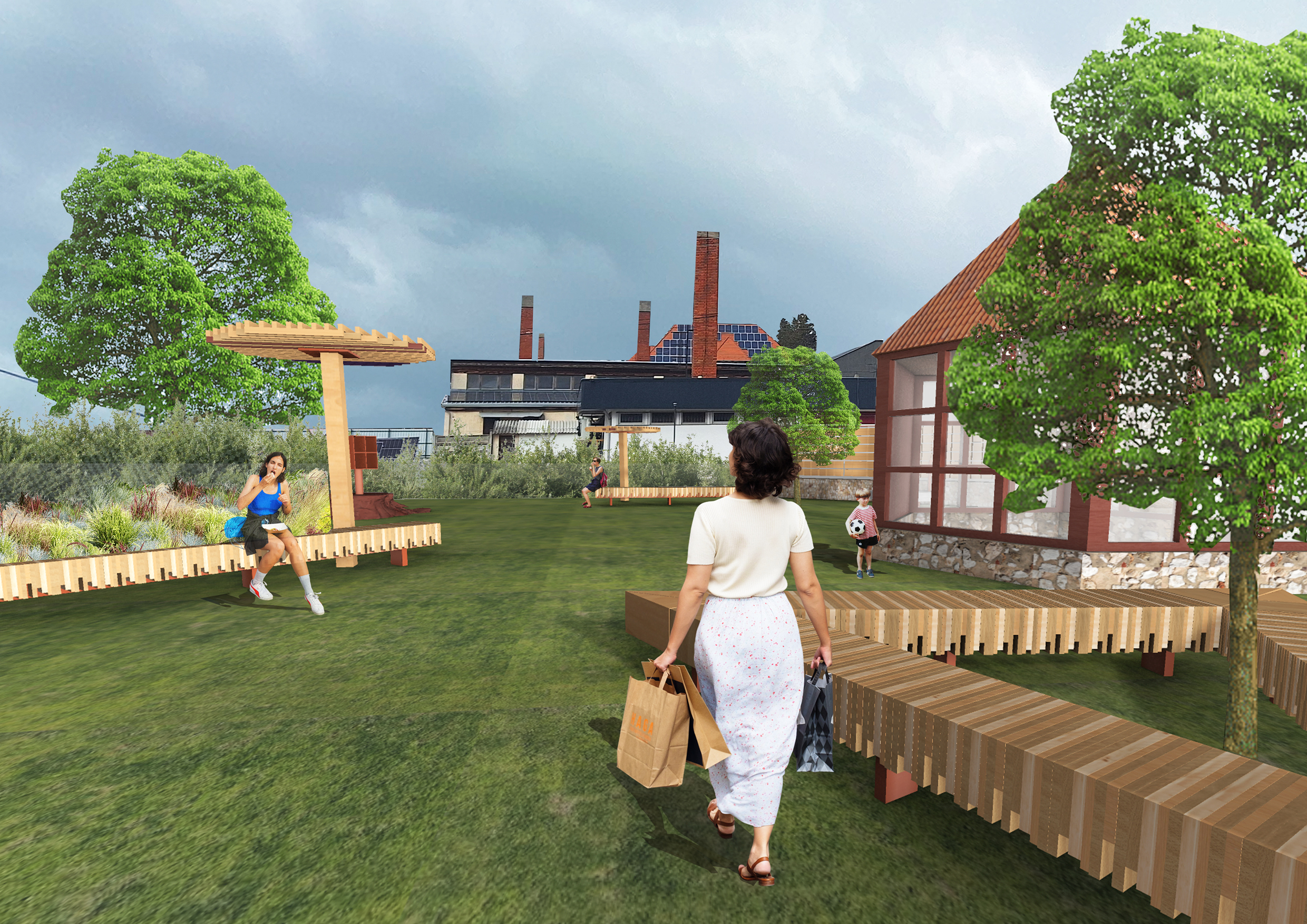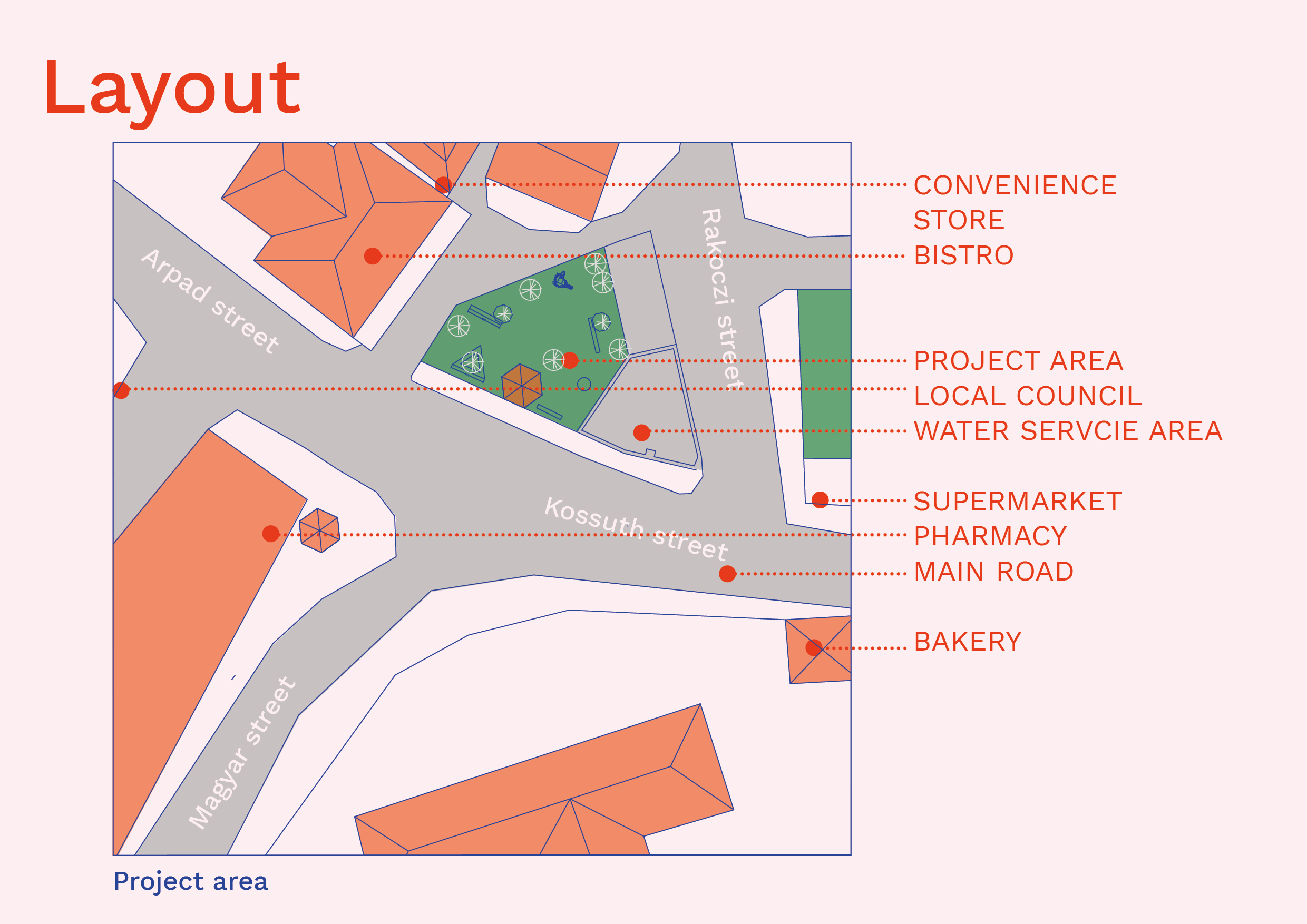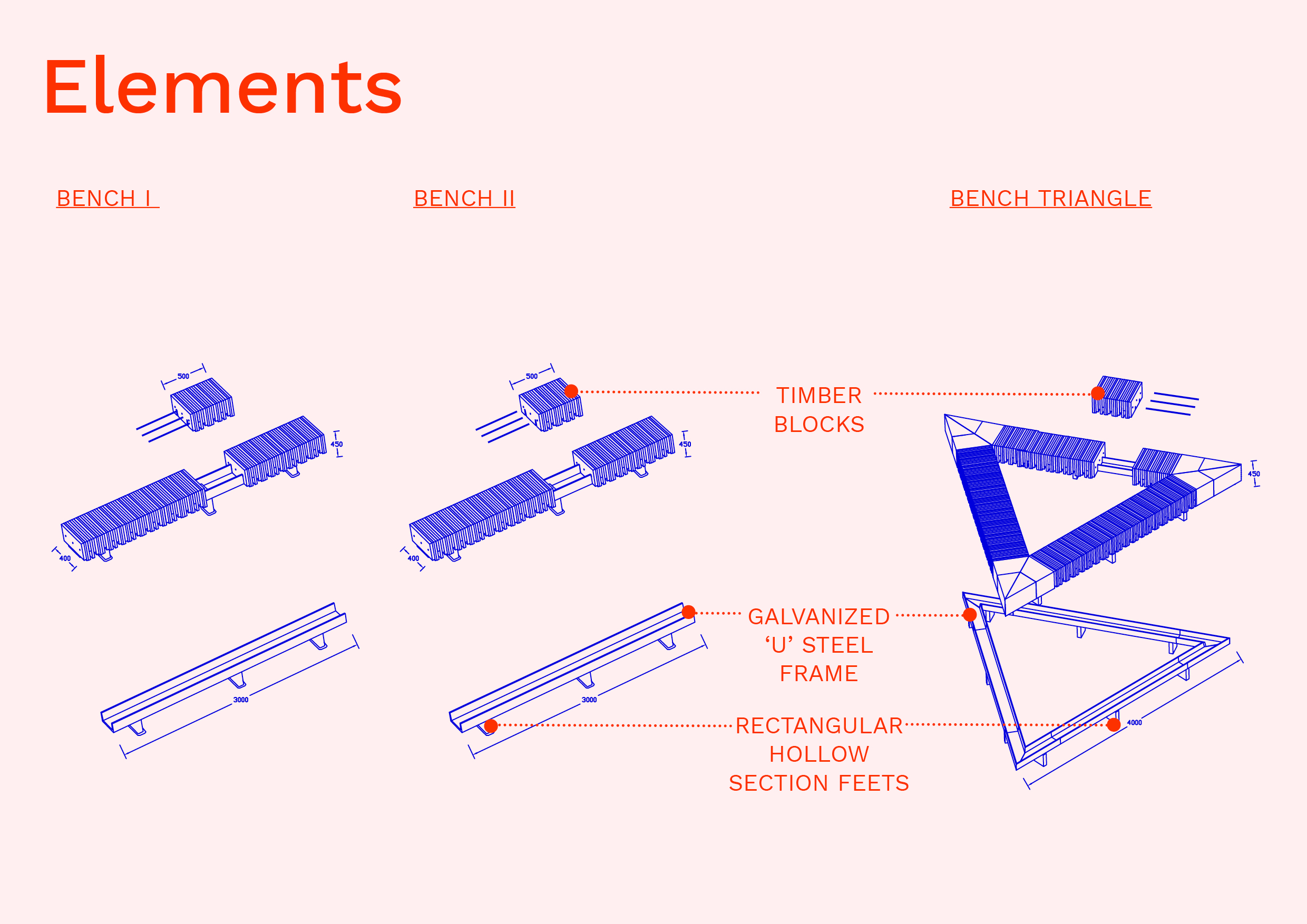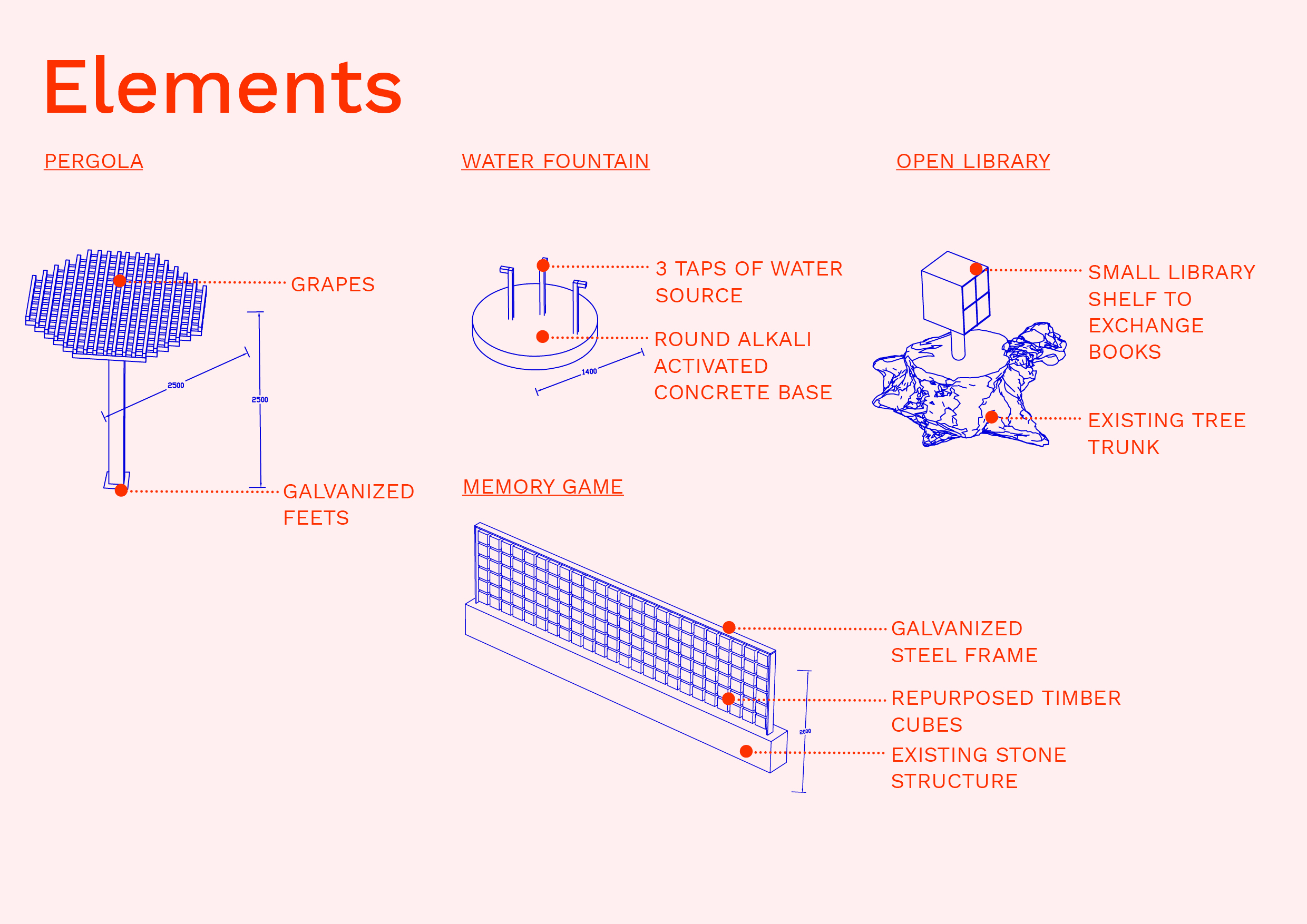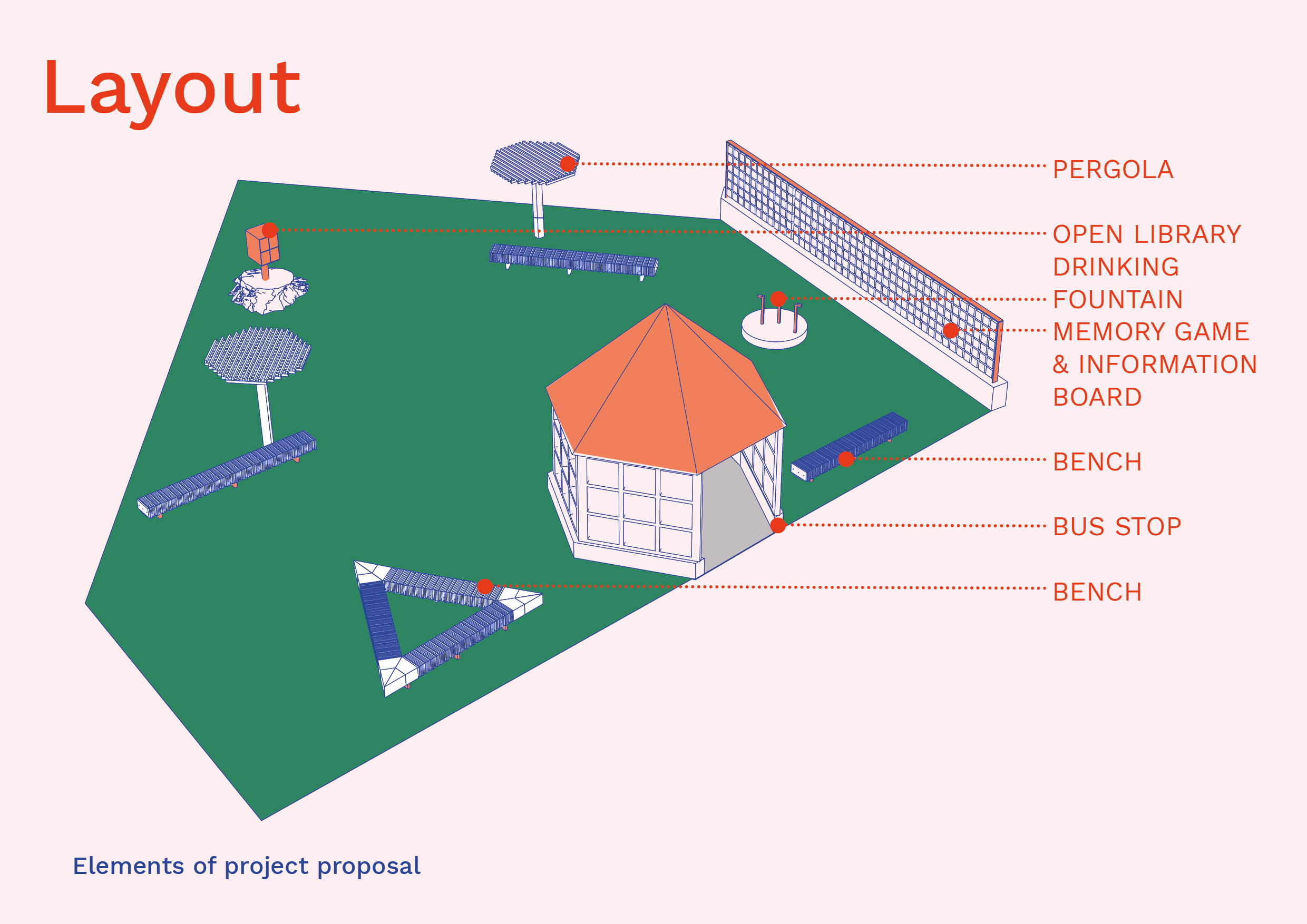Shaping the Future
Shaping the Future - Sustainable placemaking sites in Csabrendek
Shaping the Future is a sustainable, small community placemaking initiative in Csabrendek, West-Hungary. Creating exciting public spaces is fun, but it gets even better, when the main resource is waste material, and the actual users are included in the process. The envisioned result? Original design objects that serve and represent a small, but diverse community, while cultivating sustainable waste recycling best practices.
Hungary
8474, Csabrendek, Central Bus Station
Land registration number: 304/3
Land registration number: 304/3
Early initiative
Yes
Yes
Yes
No
No
30924: Csabrendek (HU)
'Shaping the Future' is the long-term sustainable and participatory public space revitalisation project of Csabrendek municipality. The first site is a now-abandoned central area, and the aim is to transform it to an accessible and open outdoor community space that is designed to serve all the residents regardless of age, gender or ethnicity using locally recycled timber waste material only and working with local stakeholders mainly. The location of the community space naturally invites a very diverse group of people, being situated at a busy intersection, near the grocery store, the post office, the community centre and the bistro. While meeting the very strict sustainability, participatory and co-creation criteria, the project also aims to create a distinctive public space design that invigorates the local collective identity and enhances a positive image of the city brand. Furthermore, the project also aims to bring awareness on the various ways timber waste can be recycled on an individual or community level, while also educating the residents about the harmful ways of reuse that should be avoided (e.g. construction waste for firewood).
'Shaping the Future' is the umbrella term of the project, under which several sites within Csabrendek are going to be renewed following the above mentioned principles. The individual site names are going to be suggested by the locals to make them more local and engaging.
'Shaping the Future' is the umbrella term of the project, under which several sites within Csabrendek are going to be renewed following the above mentioned principles. The individual site names are going to be suggested by the locals to make them more local and engaging.
Placemaking
Waste transformation
Recycling
Participatory design
Modular design
One of the main purposes of the project is to use as much recycled material and more specifically construction waste as possible. Anna Horváth, local resident, architect and designer who is the project lead has an extensive background in working with construction and industrial waste within the framework of her ongoing, cross-border project called SORGI. Boldogfa Ltd., a local manufacturer making hardwood playgrounds has offered leftover wood for the more disadvantaged residents as firewood in the past years. The company also provides some 100+ jobs locally. The leftover pine wood that is not suitable for burning is going to give the core of the building materials used in the project, thus recycling Boldogfa Ltd.’s waste locally. Eurofa Kft., another manufacturer from the neighbouring village will provide additional hardwood waste to ensure the durability and the textural diversity of the wooden parts. The other main material ensuring the durability of the objects and the sustainability of the project is galvanised steel. Moreover, the currently standing ex-kiosk hut next to the bus stop will be demolished, and its wood waste is also going to be included in the production. Other recycled materials include dismantled roof tiles and bricks. The bricks will be used for paving the ground around the outdoor furniture, and they also facilitate good, natural drainage. There is a strong collaboration with the local waste management facility and the project also promotes proper waste management to the residents. Debris produced at the development site will be transported to the junkyard, while the bricks and roof tiles are going to be selected there from communal waste.
Wood waste is often used for heating adding to the already enormous air pollution problem of Hungary that has even increased due to the rising energy prices. While offering feasible recycling alternatives, the project also aims to raise awareness on the very current issue of waste burning and air pollution.
Wood waste is often used for heating adding to the already enormous air pollution problem of Hungary that has even increased due to the rising energy prices. While offering feasible recycling alternatives, the project also aims to raise awareness on the very current issue of waste burning and air pollution.
The site of the 'Shaping the Future' project is a central hub of Csabrendek. It is placed between the grocery store and the post office. Individually, all these places are typical meeting points for residents, but in their current setting they are scattered. This precious central area is an eclectic mix of the concrete base of a former statue, an ex-kiosk hut and the bus station. The design specifically focuses on creating an accessible, open public space that can connect residents from all these scattered places. To the project’s advantage, in such a small community, walking and cycling are still the preferred transportation methods, allowing spontaneous personal meetings.
The project will be carried out in collaboration with the locals. The plans of each phase will be presented to them at different community meetings to discuss the concepts. Local craftsmen play a pivotal role in both the design and the production phase. Furthermore, some elements will be produced by the local elementary school students and the members of the senior’s club. These inclusion measures enhance the residents’ personal attachment to the objects, and foster responsibility and partnership.
As outdoor timber structures have limited durability, the design puts high emphasis on modularity. The wood waste is going to be assembled into specifically designed individual blocks that can easily be replaced in case of erosion or malfunction.
The intervention puts as much emphasis on meeting the participatory, sustainability and modularity criteria as the artistic qualities, and aims for a distinctive design. The contemporary design pieces have the potential to shape the image of Csabrendek, thus contributing to its urban development.
The design plans also include a “little free library” box, a drinking-fountain, an information board and a board game, in order to add a more personal touch to the site, and to strengthen the community.
The project will be carried out in collaboration with the locals. The plans of each phase will be presented to them at different community meetings to discuss the concepts. Local craftsmen play a pivotal role in both the design and the production phase. Furthermore, some elements will be produced by the local elementary school students and the members of the senior’s club. These inclusion measures enhance the residents’ personal attachment to the objects, and foster responsibility and partnership.
As outdoor timber structures have limited durability, the design puts high emphasis on modularity. The wood waste is going to be assembled into specifically designed individual blocks that can easily be replaced in case of erosion or malfunction.
The intervention puts as much emphasis on meeting the participatory, sustainability and modularity criteria as the artistic qualities, and aims for a distinctive design. The contemporary design pieces have the potential to shape the image of Csabrendek, thus contributing to its urban development.
The design plans also include a “little free library” box, a drinking-fountain, an information board and a board game, in order to add a more personal touch to the site, and to strengthen the community.
'Shaping the Future' is a placemaking initiative, and as such, puts significant emphasis on participatory processes. The project designer and the municipality collaboratively present some plans and ideas, which are tightly negotiated with local craftsmen and entrepreneurs, and periodically discussed with the citizens. The final decision is made by the board of representatives, the executive body of the municipality. Since 'Shaping the Future' is made for the people, it is essential that they feel invested and also clearly articulate their needs and desires. Therefore, periodical community forums are an integral part of the project, where locals are presented with multiple design options, and have the opportunity to discuss the project or to select one of the presented options. One community forum is specifically designed to map out other potential sites where the Shaping the Future project can be continued. In addition, locals will be encouraged to participate in the naming process within the framework of a public ‘name proposal’ stage to make the final public space communally more relevant and relatable.
Besides the partnership with local craftsmen and entrepreneurs, some phases of the production are going to be carried out by the students of the local elementary school and the members of the seniors’ club. These collaborations are also great occasions for waste recycling education and raising awareness.
'Shaping the Future' aims for permeability and connectivity as well as accessibility. The central and hub-like location is perfect for inviting people with very different backgrounds to share this public space.
Such a complex public site development in a small community is a huge added value to the character of the municipality, that makes the village more attractive to newcomers. Furthermore, due to the project’s participatory nature, people feel more involved, more attached and very proud which strengthens their collective identity.
Besides the partnership with local craftsmen and entrepreneurs, some phases of the production are going to be carried out by the students of the local elementary school and the members of the seniors’ club. These collaborations are also great occasions for waste recycling education and raising awareness.
'Shaping the Future' aims for permeability and connectivity as well as accessibility. The central and hub-like location is perfect for inviting people with very different backgrounds to share this public space.
Such a complex public site development in a small community is a huge added value to the character of the municipality, that makes the village more attractive to newcomers. Furthermore, due to the project’s participatory nature, people feel more involved, more attached and very proud which strengthens their collective identity.
The final site can become an iconic spot that can turn an unknown location into a destination. We need such public spaces to bring the members of the civil society together. The residents not only get an open, accessible public space, but throughout the entire process they learn a lot about sustainability, the many different ways of recycling and collaborative work. Moreover, they see and physically experience how a sustainable object comes to life, how mundane and viable such a project can be, something that otherwise may sound ambiguous, abstract and complicated to the everyday person. Contrary to a conventional commissioned work, the emphasis on participation and collaborative work turns this project into a playful, almost fluid process, where many different aspects can be explored and incorporated into the final design. On one hand, this is rather challenging to the main stakeholders, but on the other hand this is what makes the final space and objects local and useful, best serving their purpose.
From a more technical point of view, the main resource, the locally produced timber waste poses several challenges to the design and implementation. Thus the design has to be very carefully developed in order to meet the sustainability, modularity and participatory criteria, and to also become a landmark of the village.
From a more technical point of view, the main resource, the locally produced timber waste poses several challenges to the design and implementation. Thus the design has to be very carefully developed in order to meet the sustainability, modularity and participatory criteria, and to also become a landmark of the village.
There are four main groups of actors throughout the development: Ms Anna Horvath architect-designer, the municipality, the local entrepreneurs and the residents. The municipality of Csabrendek has prior experience with urban development projects, and is very keen on innovative collaborations. The municipality undertakes the administrative tasks, and it acts as an umbrella organization connecting all actors in the process.
As the most important guiding keyword throughout the project is ‘local’, almost all of the stakeholders are local: the designer, the municipality, the subcontractors and the residents, except for Eurofa Ltd. that is located at a nearby village, Bazsi. There is however, one future regional stakeholder, the Balaton Uplands National Park Directorate. The project plans to expand in the future, and one of the proposed spots the “Kőkatlan trail of Csabrendek” lies at an UNESCO heritage site, the Bakony–Balaton UNESCO Geopark.
As the most important guiding keyword throughout the project is ‘local’, almost all of the stakeholders are local: the designer, the municipality, the subcontractors and the residents, except for Eurofa Ltd. that is located at a nearby village, Bazsi. There is however, one future regional stakeholder, the Balaton Uplands National Park Directorate. The project plans to expand in the future, and one of the proposed spots the “Kőkatlan trail of Csabrendek” lies at an UNESCO heritage site, the Bakony–Balaton UNESCO Geopark.
There are three main disciplines at the core of the project: narrative space design, project coordination and administration, and sustainable construction. In this interdisciplinary mix, the cultural representative of the municipality is the central actor. She is responsible for the entire project coordination, most of the communication (both internal and external), and she manages the administrative tasks of the municipality as well. Furthermore, she is responsible for the planning and organizing of the community forums. In her cultural- and event manager role, she has an extensive network and very good connections with the local residents. It is important to mention that a significant part of the project communication happens informally, on the streets, at the grocery store, etc. This is a relatively small community, where informal communication still plays a vital role in the streamlining of information.
The design and the concept are done by ex-local resident and founder of AHA Objects design studio Ms Anna Horváth. Anna holds a BSc in Architecture (MOME, Budapest) and an MSc in Narrative Environments (Central Saint Martins, London), and her main focus in the past decade has been sustainable design, locally sourced materials, participatory design and waste management (with a special focus on construction waste). Last year, together with the municipality Anna started the revitalization of a local architectural heritage, the abandoned 18th century baroque-style Bogyai-Gyarmathy curia, which aimed to be turned into a cultural hub with exhibitions and residencies after some renovation.
Local craftsmen were invited to participate in the planning and execution of the project. The carpenter and locksmith play a pivotal role in the design of the wood elements, the waste manager coordinates the incoming and outgoing waste, while the gardener designs the natural environment of the project. All subcontractors consult with Anna to achieve maximum sustainability.
The design and the concept are done by ex-local resident and founder of AHA Objects design studio Ms Anna Horváth. Anna holds a BSc in Architecture (MOME, Budapest) and an MSc in Narrative Environments (Central Saint Martins, London), and her main focus in the past decade has been sustainable design, locally sourced materials, participatory design and waste management (with a special focus on construction waste). Last year, together with the municipality Anna started the revitalization of a local architectural heritage, the abandoned 18th century baroque-style Bogyai-Gyarmathy curia, which aimed to be turned into a cultural hub with exhibitions and residencies after some renovation.
Local craftsmen were invited to participate in the planning and execution of the project. The carpenter and locksmith play a pivotal role in the design of the wood elements, the waste manager coordinates the incoming and outgoing waste, while the gardener designs the natural environment of the project. All subcontractors consult with Anna to achieve maximum sustainability.
Contrary to traditional urban development and revitalisation projects, where the municipality publishes a tender, and a contractor creates the plans according to the spatial, financial and branding measurements, 'Shaping the Future' builds up from within the community. This development puts high emphasis on citizen engagement, participatory design and sustainability, rather than isolatedly creating a world-class design concept that the locals feel detached from. The final outcome is heavily influenced by these participatory processes, the large number of stakeholders and also the limited technical viability of the waste material. These above mentioned aspects, however, ensure that the project is local, sustainable, affordable and replicable. The central public space is planned to be the prototype for more similar sites within Csabrendek, as part of a larger urban development concept. The process also ensures the residents’ personal attachment to the site, enhancing their willingness to utilize the community park and to look after it.
The project also undertakes the challenge of fulfilling and fusing four major aspects, namely that it should be sustainable, local, affordable and replicable. These alone are quite considerable fields, and to successfully merge them, is what makes 'Shaping the Future' a one-of-a-kind undertaking.
The project also undertakes the challenge of fulfilling and fusing four major aspects, namely that it should be sustainable, local, affordable and replicable. These alone are quite considerable fields, and to successfully merge them, is what makes 'Shaping the Future' a one-of-a-kind undertaking.
The starting point of the project was an intense creative brainstorming between the municipality and the designer, in which they identified the key problem areas and the possible opportunities for development. It has long been on the agenda of the municipality to renovate public spaces in a contemporary, sustainable way, and Anna is not only a local who has recently returned after a decade from abroad, but she also has extensive experience with sustainable developments and city branding.
The guiding keyword throughout the design process has been: local. The focus is on local resources, local knowledge and skills, something that reflects the local social context and is site-specific. The design, while aiming to be distinctive and characteristic, has to be feasible by local entrepreneurs, and it has to rely on local resources, mainly timber waste. The participatory nature also poses certain limitations, but at the same time this feature enables the final design to truly convey the local characteristics.The second guiding principle has been: modularity. Since these installations will be used by people and wood is not the most durable material, the design has to be simple and easily replaceable. By creating uniform blocks of compressed timber waste, broken or eroded elements can simply be replaced. Another aspect is adaptability: this combination of durable galvanised steel and recycled wood has to be applicable to other objects as well for the future continuation of the 'Shaping the Future' project. For instance, the same modular blocks used for this public space should be applicable to a fence or a lookout tower (that are definite plans for the continuation of the project). The strength of this material combination is that the wood is recycled and replaceable, while the galvanised steel ensures durability.
Civil involvement will happen personally at community forums, and there will be regular updates and surveys published in the local newspaper and online.
The guiding keyword throughout the design process has been: local. The focus is on local resources, local knowledge and skills, something that reflects the local social context and is site-specific. The design, while aiming to be distinctive and characteristic, has to be feasible by local entrepreneurs, and it has to rely on local resources, mainly timber waste. The participatory nature also poses certain limitations, but at the same time this feature enables the final design to truly convey the local characteristics.The second guiding principle has been: modularity. Since these installations will be used by people and wood is not the most durable material, the design has to be simple and easily replaceable. By creating uniform blocks of compressed timber waste, broken or eroded elements can simply be replaced. Another aspect is adaptability: this combination of durable galvanised steel and recycled wood has to be applicable to other objects as well for the future continuation of the 'Shaping the Future' project. For instance, the same modular blocks used for this public space should be applicable to a fence or a lookout tower (that are definite plans for the continuation of the project). The strength of this material combination is that the wood is recycled and replaceable, while the galvanised steel ensures durability.
Civil involvement will happen personally at community forums, and there will be regular updates and surveys published in the local newspaper and online.
On one hand, the project aims to explore other potential sites and site-specific objects for development within Csabrendek. An entire community assembly is dedicated to exploring other, future sites where the methods developed throughout the prototype site could be further utilised. The modular and cost-effective design opens a lot of doors for future developments. Whether it be ‘gossip benches’ or a little bridge over the canal or other library boxes, the residents will know best.
This methodology can be applied to other small communities, like villages, districts, residential communities, eco-communities, etc. where there is any sort of construction or industrial waste that can be utilised for public purposes. This way, the recirculation of waste material is not a top-down process, but leaves room for innovative uses that best reflect local needs and characteristics.
As explained earlier not only the installation can be repeated but the combination of durable galvanised steel and recycled wood has to be applicable to other objects as well for the future continuation of the Shaping the Future project. For instance, the same modular blocks used for this public space should be applicable to a fence or a lookout tower (that are definite plans for the continuation of the project). The strength of this material combination is that the wood is recycled and replaceable, while the galvanised steel ensures durability, and both are 100% recyclable.
This methodology can be applied to other small communities, like villages, districts, residential communities, eco-communities, etc. where there is any sort of construction or industrial waste that can be utilised for public purposes. This way, the recirculation of waste material is not a top-down process, but leaves room for innovative uses that best reflect local needs and characteristics.
As explained earlier not only the installation can be repeated but the combination of durable galvanised steel and recycled wood has to be applicable to other objects as well for the future continuation of the Shaping the Future project. For instance, the same modular blocks used for this public space should be applicable to a fence or a lookout tower (that are definite plans for the continuation of the project). The strength of this material combination is that the wood is recycled and replaceable, while the galvanised steel ensures durability, and both are 100% recyclable.
There are two main problem areas where 'Shaping the Future' aims to offer solutions in its local context: isolation and climate change.
Societies are becoming more and more fragmented and isolated. It is due to a number of reasons globally, but in a local context we can identify for instance the aging village population, vanishing community customs, the main communication channels and forms of contact being online or access to social events. The numerous lockdowns during the recent covid 19 pandemic just amplified these processes. Contemporary consumer and entertainment habits favor the bigger cities, and leave smaller communities at the risk of fragmentation and isolation. At the same time, in Hungary we currently see a rise in counter urbanisation processes, especially among young families, which challenges smaller communities to be more attractive, and to invest in urban developments.
Over-consumption and over-production hand-in-hand amplify the climate crisis by generating an enormous amount of waste, and there is a need for feasible recycling programs for citizens. The term waste semantically excludes its recycling opportunities, which could be changed by education and raising awareness. Even traditional waste management is full of misunderstandings and misuse within the broad Hungarian society, let alone the sustainable aspects. 'Shaping the Future' aims to educate citizens by showing them hands-on, feasible ways to reuse wood waste, and teaching them about the uses to avoid when recycling wood - even with the best intentions. And small communities provide a great starting point or platform to successfully achieve these aims.
Societies are becoming more and more fragmented and isolated. It is due to a number of reasons globally, but in a local context we can identify for instance the aging village population, vanishing community customs, the main communication channels and forms of contact being online or access to social events. The numerous lockdowns during the recent covid 19 pandemic just amplified these processes. Contemporary consumer and entertainment habits favor the bigger cities, and leave smaller communities at the risk of fragmentation and isolation. At the same time, in Hungary we currently see a rise in counter urbanisation processes, especially among young families, which challenges smaller communities to be more attractive, and to invest in urban developments.
Over-consumption and over-production hand-in-hand amplify the climate crisis by generating an enormous amount of waste, and there is a need for feasible recycling programs for citizens. The term waste semantically excludes its recycling opportunities, which could be changed by education and raising awareness. Even traditional waste management is full of misunderstandings and misuse within the broad Hungarian society, let alone the sustainable aspects. 'Shaping the Future' aims to educate citizens by showing them hands-on, feasible ways to reuse wood waste, and teaching them about the uses to avoid when recycling wood - even with the best intentions. And small communities provide a great starting point or platform to successfully achieve these aims.
The municipality has long planned to start a public revitalisation project which promotes sustainable values, and already allocated 6.000.000 HUF of its budget to the realisation of the first, central public space. On behalf of the municipality, the whole project is a long-term objective, and therefore takes a lot of meticulous planning in order to be adaptable and replicable.
The project started in 2024 with identifying the existing public spaces, the key problem areas and the possible opportunities for development. Since then, there has been an active phase of planning and coordination on the creative, engineering and administrative fields. On the 11th of February, the first community assembly took place in the local community center, and the residents shared some valuable insights and articulated their needs and ideas based on the printed version of the first designs that were on display. Now, the project designer and the municipality are both working on implementing the findings and results of the community assembly into the design concept. During the summer, the municipality will start to do an overall cleanup at the site, and the kiosk hut’s timber material will be transported to the local carpenter. Parallel to the cleanup, production will start on behalf of the designer and the entrepreneurs, with the active involvement of students and the senior club (from September, 2025 onwards). The metal construction will entirely be carried out in the locksmiths studio, but locals will be actively involved in the shaping of the modular wood blocks. In February, 2026 transportation and installation will start with the involvement of volunteers, and in June, the gardening duties will be carried out by the local gardener and members of the senior’s club. Simultaneously, in this last phase, the municipality will invite the locals to propose names to the specific site in the centre. The ribbon cutting ceremony is planned to take place in September, 2026.
The project started in 2024 with identifying the existing public spaces, the key problem areas and the possible opportunities for development. Since then, there has been an active phase of planning and coordination on the creative, engineering and administrative fields. On the 11th of February, the first community assembly took place in the local community center, and the residents shared some valuable insights and articulated their needs and ideas based on the printed version of the first designs that were on display. Now, the project designer and the municipality are both working on implementing the findings and results of the community assembly into the design concept. During the summer, the municipality will start to do an overall cleanup at the site, and the kiosk hut’s timber material will be transported to the local carpenter. Parallel to the cleanup, production will start on behalf of the designer and the entrepreneurs, with the active involvement of students and the senior club (from September, 2025 onwards). The metal construction will entirely be carried out in the locksmiths studio, but locals will be actively involved in the shaping of the modular wood blocks. In February, 2026 transportation and installation will start with the involvement of volunteers, and in June, the gardening duties will be carried out by the local gardener and members of the senior’s club. Simultaneously, in this last phase, the municipality will invite the locals to propose names to the specific site in the centre. The ribbon cutting ceremony is planned to take place in September, 2026.

